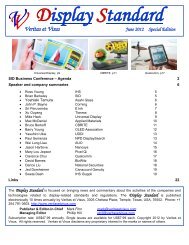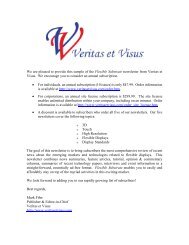Create successful ePaper yourself
Turn your PDF publications into a flip-book with our unique Google optimized e-Paper software.
<strong>Veritas</strong> <strong>et</strong> <strong>Visus</strong> <strong>Display</strong> <strong>Standard</strong> February 2009<br />
along the 45° azimuth versus incidence angle and gray level (c.f. Figure 6). The wavelength is fixed at 549nm as<br />
for Figure 5. We see that the maximum of ellipticity is not for normal incidence and does not reach 45°. The<br />
degradation of polarization degree at high angles drives the angle of view of the display.<br />
All these data can be used to evaluate the best top surface polarizer. One easy way to read the polarization data is to<br />
use the Poincare sphere as shown in Figure 7. The evolution of the S1 and S2 Stokes vector is characteristic of the<br />
polarization rotation of the crystal cell and the influence of the incidence angle is particularly clear. The influence<br />
of the LC can be decomposed in an equivalent optical<br />
r<strong>et</strong>ardation and one rotation. 7 These two param<strong>et</strong>ers<br />
can be easily driven from the present data. The<br />
rotation is in particular strongly dependent on the<br />
angle. The r<strong>et</strong>ardation is exactly at 45° only for +50°<br />
incidence in this case. The rotation and the orientation<br />
of a combined waveplate and polarizer to compl<strong>et</strong>e the<br />
LCD in the most efficient conditions can be derived.<br />
Of course the efficiency of the display must be<br />
maximized for all the visible range. Using<br />
EZContrastMS, the same polarization analysis can be<br />
made at all the wavelengths of the instrument. One<br />
example is reported in Figure 8. We report the<br />
ellipticity and orientation of the light emitted by the<br />
display versus gray level and at three wavelengths<br />
(549nm already used in Figures 6-7, 487nm and<br />
609nm). We d<strong>et</strong>ect small dependence of ellipticity and<br />
orientation versus wavelength as weighted for a liquid<br />
crystal cell. The variations are essentially due to the<br />
variation of the optical indices of the LC versus<br />
wavelength. These variations must nevertheless be<br />
taken into account to ensure optimal performances at<br />
all wavelengths. For the present LCD it is clearly not<br />
the case as we have seen on the gray level analysis of<br />
the radiance.<br />
Figure 8: Normal incidence evolution of ellipticity and orientation versus gray level at different wavelength<br />
61<br />
Figure 7: Evolution of stokes vector versus gray level at<br />
different incidence along 45° azimuth (the wavelength is<br />
fixed at 549nm)






